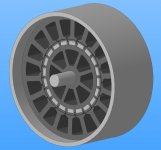Miles said:4000 rpm / 60 x 8 pole pairs = 533Hz commutation frequency.liveforphysics said:Just as some design info, the Sevcon is limited to ~500hz commutation freq (if I remember correctly).
The Kelly Ultra-High-Speed option is limited to 1100hz (in my testing, and it was getting glitchy past 1000hz).
I think the "infinions" can do something around 2000hz (but there have been so many versions and chips used by this point, I have no idea what current ones do).....
ive been fondling with some high speed and ultra high speed kellys and the (quite similar) ca 120 (2.3kg) motor lately, and the kellys are good for quite a bit of commutation speed,
the high speed option (kelly quote 70000 erpm max) can do this and more.
so this motor has 28 mags (and a large 120mm can od and 24 teeth), so its 14 pole pairs so the kelly should run it up to 5000rpm. ive had it around 6000 just in the last few days (with a burties timing module a key ingredient..) and it handles this rpm well, the ultra high speed kellys quote 100000erpm so should do 7143rpm or more, and i can test this out if needed.
with this and the desire for a single stage reduction in mind, i believe you may want a higher pole count. this ca 120 motor has more poles than any other rc motor of this type and this changes stuff; firstly the no load losses are much higher for a given rpm than people seem to expect, so most are turned off straight away, but with this high a pole count AND 120mm can you dont want or need above 7000rpm as theres so much going on before this anyway, this along with double length teeth (with another near doubling of the iron losses) allows for double the copper, and all in all you have a motor that is very suited to low rpm high sustained torque.
seems to me like its having all the (both positive and negative) effects of high rpm without it acctually being that high, so to keep down the noise and gearing issues im thinking this is what you are after. and btw im thinking you would get more much needed inductance from more poles too?
the (2.5 times the kg) collosus is the opposite of this motor in these ways as its only 20 mags, lower inductance (suprisingly similar resistance) and wants revs.
-quality is not the problem, the collosus is extra hard to drive due to low inductance and simply scared everyone by needing around $1000 worth of controller, not a big drama though, works nicely in splinteroz's roadbike.
arlo put quite an effort into increasing inductance on the collosus -without success from winding changes iirc.
is it fair to say though, that more poles (well teeth really) give higher inductance, as there are just more little inductors inside?


